RENEGADE GARDENER™
The lone voice of horticultural reason
My Last Damn Rant About Red
06-17-09 – Not quite the record for tardiness when it comes to posting a new update – in that regard, I’m early with a week to spare. Nonetheless, everything you’ll read and see today is fresh. The top four feature buttons to the left contain a hip plant, a fab product, a heart–wrenching tale and a helpful admonishment. But first I’ll get on with the main course, titled:
My Last Damn Rant About Red

This spring I spent two months feverishly working on my house to get it ready for sale (it hasn’t), spent a day in the emergency room with a hand injury (I’m fine), showed up on time, mostly, for dozens of landscape consultations (and nabbed a good number of great jobs, my theory about the dire economy further below), all while blasting off five articles for two new publications that apparently didn’t check my credentials, or did, and hired me as a garden writer anyway.
So I’m feeling tired, enthused, worried, relieved, pained and pumped, and when I write in this rarified state, I have to warn you, I’m tough on beginners.
New gardeners, red is a dastardly, mischievous, Gordian knot of a color that beginning gardeners latch onto with the temerity they would grasp a potion granting eternal life. Or at the very least, a cream that actually does erase wrinkles around the eyes. Eureka! I have found the secret to creating beautiful garden beds and flower containers: Douse my yard with RED!
Repeat after me: Red is not a desirable, useful flower color for the garden. Reddish foliages, hell yes, but when choosing bloom colors, plant a hair more than a little red and red becomes a thief, a lout, a boor, a drunken, obnoxious party guest that doesn’t leave until 2:30 a.m. after the booze runs out. Red is for rubes.
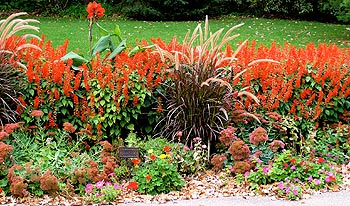 |
| Colorful? Well, yes, in a rather drunken, boorish way. Beautiful? Hardly. |
Oh, red is definitely seductive. A woman doesn’t head out on the town in red lipstick and a little red dress hoping for an evening of coffee-laced conversation with a vested college engineering professor, and a guy doesn’t drive a red Corvette or Ferrari for the wonderful gas mileage. Red gets you noticed.
Red blooms will certainly get noticed in the garden (during daylight, anyway), but here, too much red is like too much chocolate cake, too much vodka, too much Midwestern seafood: Go over the edge, you puke.
Red is the strongest color there is in terms of, well, I don’t know the exact scientific equation, but call it density. Red is so densely colorful, so loud and commanding, that it sucks the color out of everything near it. I once saw a large landscape, new home construction, which had been sculpted with a magnificent array of small trees, dwarf conifers, myriad shrubs, unique sculptures, and artistic stone outcroppings. All this work was done in the fall. The perennials were planted the next spring, in small clusters here and there, filling some gaps.
A lot of Russian Sage (Perovskia) was popped in along the borders, and it was bare-root, so when planted was little more than clusters of short, gray sticks. You weren’t going to see the silvery green foliage for at least a month, or the rich blue blooms until midsummer.
The homeowners couldn’t wait. All along the front edge of the large, deep, sweeping beds they planted red annuals, a lot of red salvia and red dahlias, piping hot and bloom-filled from the spring greenhouses. And from two blocks away, fifty feet away, or standing at the edge of the landscape, all you saw was this red line of blooms in front. Six figures of landscaping that included just about every plant form, foliage color and texture contrast that could be created virtually disappeared. I didn’t have my camera, and don’t believe I would have had the strength to shoot a picture if I had.
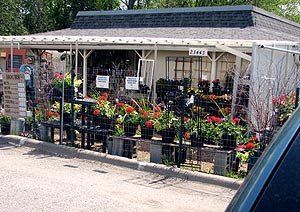 |
| The first color you see when you pull up to the nursery. |
You can’t use red in any quantity in the front of the bed. It banishes the colors behind it. You can’t use great quantities of red in the middle or along the back of the bed, it sucks the color out of the blooms in front. Red is tricky. And it’s the only color that is, except perhaps for orange, but don’t get me started. So guess what color is most overused by new gardeners? The tricky one: red.
It’s not close to being your fault, beginners. The nursery industry is taking advantage of your naiveté. They ram the red plants to the front of the lot where they are the first things you see as you park and walk up. It’s spring, the world around you is brown and boring, you are craving intense color, so the nurseries gleefully grant you a lethal dose. And nowhere is this more horrifically evident than in the sale of the most aesthetically toxic plant on the planet, the red geranium.
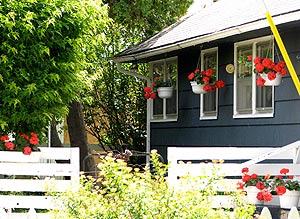 |
| The great tragedy is that once ensnared by the red geranium’s satanic grasp, it often becomes a lifelong affliction. |
I’ve told this tale on the site before, I’ll keep it brief, there is a wonderful independent nursery outside of Cedarburg, Wisconsin, run by a woman who knows her stuff and who grows the most fabulous annuals from seed. Linum, Gaura, Amaranthus, Lavatera, Iberus, Lisianthus, Salpiglossus, all the cool stuff one would never find at the Home Depot, or even most standard nurseries.
The nursery is out in the country, at the dead end of a quarter-mile gravel road. Back up at the highway, at the start of this gravel road, is a large, carved and painted wood sign with the name of the nursery. On the day I visited, the proprietor had apparently tired of the customers who pull up to her penned yard only to have their quarter-mile, dust-clogged journey end in disappointment, for next to this ornate nursery sign was a second sign, hand-lettered on cardboard, reading, “We do NOT sell red geraniums!”
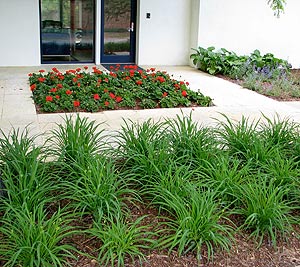 |
| The worst of the worst: A commercial installation, a bed of red geraniums fronted by a bed of Stella de Oro daylilies. Lord, give me strength. |
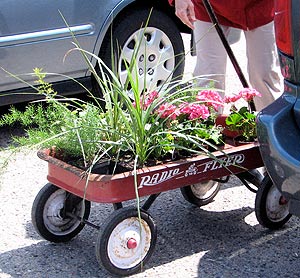 |
| This gardener must already own the plastic, fake terra cotta pot, it’s the only thing missing. About a twenty-incher, I reckon |
You either get that story or you don’t.
Red geraniums are a beginner’s plant, like daylilies, and purchasing five or ten or twenty red geraniums, then planting them in containers and flower boxes and in little circles around your mailbox is an activity you will think about at some point in the distant future and chuckle over. You can shoot me all the e-mails you like about how wrong I am and how much you adore red geraniums, the important e-mail is the one you’ll send me in ten or fifteen years.
The salmon and other pink-having-sex-with-red geraniums that the nursery geeks have concocted in their high-tech botanical brothels offer some relief, certainly, but dressing your landscape with an overabundance of off-red geraniums is hardly a cure for what ails you and your yard. Too much salmon is still, well, too much salmon. If you’re hot for red and its kin, I guarantee you are not using enough white in your gardens, not enough deep yellow, and when they stick something blue in with the red, people think they’re designing.
Next time you do a multiple-plant container of annuals, try it with blooms of pale pink and yellow and blue. Or white, yellow and blue. If you’re only sticking one blooming plant in a small pot, try a white geranium. In any case, notice how the container comes alive after suppertime, and how beacon-like it becomes as evening descends. Focusing in again on the importance of white, day or night, white blooms in the garden draw one’s attention more than red, while reveling in all the colors nearby, and white positively glows in evening. Yet white is the only color not found on those useless color wheels included in every beginner’s first garden design book. It’s rigged, I tell ya.
 |
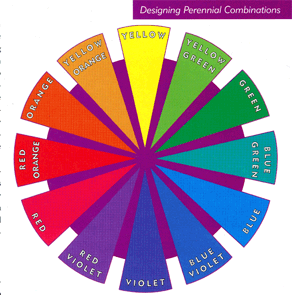 |
| The strip mall actually pays a company for this. | One of those useless color wheels. Note the absence of the color white. |
Yes, dark blue also disappears in evening, but light blue doesn’t. On summer evenings, that period of three to four hours when you and your neighbors probably view your garden most, the colors white, silver, pale blue, yellow, pale pink and light green remain highly visible, while plants with red blooms, geraniums or otherwise, turn dim, then stern, then ugly, then disappear, a sort of satanic, reverse-vampire of a color that scampers from moonlight.
Too much red creates a jarring mess of a landscape. Use it sparingly.
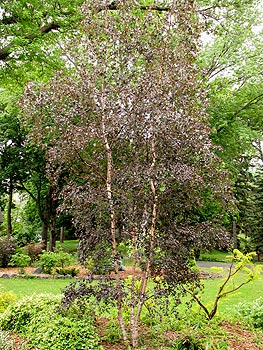 |
| Royal Frost birch in the Renegade’s Yard. |
Critter Alert
The major plant wholesalers in the Twin Cities have stopped selling Betula nigra ‘Royal Frost’ (Royal Frost Birch) as it has shown not to be resistant to Bronze Birch Borer. This is a marvelous tree, the wonders of which (maroon-red foliage, compact stature) I have extolled upon numerous times on this site, so if you’ve planted one on my recommendation, know this:
Assuming you planted the tree in full sun, just be sure to keep it watered, and fertilize it once in spring with a general all-purpose granular organic fertilizer if the soil is poor. In other words, grow a healthy tree. You should be fine. If you have just the one birch on your property, or five, for that matter, and live out in the country or in the middle of suburbia, I wouldn’t worry. Bronze birch borer has to come from somewhere, and where it comes from is nearby stands of birches.
It was one of the major growers in our area that had borers get into an entire field of Royal Frosts, hundreds and hundreds of trees. A Royal Frost growing here or there will usually fly under this pest’s radar. Still, check all your birches a few times a season for evidence of this pest. You’ll see small round holes, about the size of a BB, usually up higher than lower, and often around eye level. The holes may be clogged with sawdust, or may be weeping sap.
Unfortunately, all this tells you is that the tree is infested, and there is unfortunately no recourse but to cut it down. No chemical treatment is available. Burn the wood or haul it to a recycling site where they chip downed trees into shredded mulch. If cut for firewood, Do NOT transport the wood to another location (such as the cabin).
 |
Then there is the recent news that the Emerald Ash Borer has arrived in Minnesota, as a part of its fabulously successful cross-country tour. MN Department of Agriculture specialist just found the borer in 59 ash trees in St. Paul. And the general consensus is, we’re doomed. EAB has now been found in Michigan, Illinois, Indiana, Maryland, Minnesota, Missouri, Ohio, Ontario, Quebec, Virginia, West Virginia and Wisconsin.
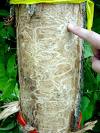 |
It’s sad news for Minnesota, yet inevitable. Michigan and Wisconsin are thoroughly infested, Minnesota has a lot of native ash trees, so it was simply a matter of time. If you live in any of the states or provinces listed above (or to south or west of them!) and want to get up to speed, here’s a quick primer on EAB:
• Early signs of infestation are increased woodpecker activity and damage.
• You’ll notice bark splitting up and down the trunk. Remove a bit and you’ll find serpentine galleries with D-
shaped exit holes (photo right).
• The canopy dies back from top to bottom, typically starting with the top third of the tree losing leaves in one
season.
• In spring, leaves develop larger than normal.
• You’ll note bushy sprouting from the trunk base and roots.
Chemical treatment by good, certified tree companies can keep an ash tree from succumbing to the borer, if caught in the early stage of infestation. Here’s a great website with complete information: www.emeraldashborer.info.
While the spread of EAB is certainly sad, it’s nothing I get too worked up about. Since the beginning of life on Earth, species, both plant and animal, have come and gone due to natural causes. The only reason that the Emerald Ash Borer is news is that this time, humans are around to report it. Every ash in North America may have been wiped out by EAB or something else a dozen times in the last 10,000 years, and it was hardly the end of the world.
I don’t mean to sound callous. If you have a lot of ash trees on your property, I sincerely think it’s awful should you lose them. They’ll need to be cut down and disposed of properly, but then, the good news: You get to plant new trees.
Lindens grow fast and are pretty, there are a couple dozen fast-growing maples of all shapes and sizes that bring dazzling fall colors, numerous varieties of Honeylocust are fast-growing, attractive, drought-resistant trees great for smaller yards, and the new disease-resistant elms should probably have been the first replacement tree I mentioned. Replace your ash with the new varieties of elms, I say. Not only are they resistant to Dutch Elm Disease, the disease has petered out because it ran out of elms.
Plant twelve to fifteen-footers of whatever type of tree(s) you choose, and in ten years you’ll have some shade and some very good-looking trees. Starting 30 years from now, the lucky owners of your property will revel in their majesty, just as you admired those beautiful ash.
Tale of Two Trees
That ash trees are in the news reminds me of a funny incident from last month, when were doing a simple back yard landscaping job in the western suburbs. The client had oodles of wonderful perennials, but as she progressed in developing her landscape over the years, she had the astute realization that her garden lacked backbone, and called The Renegade Gardener.
We popped in 21 shrubs, nine in a narrow bed along the back to block an unsightly fence, then 12 more throughout the horseshoe-shaped perennial bed, pyramidal evergreens such as DeGroots Spire arborvitae, Red Star chamaecyparis, plus small evergreens and shrubs, things like King’s Gold chamaecyparis, Flamingo willow, Tiger Eyes sumac, Limelight hydrangea, Blue Shadow fothergilla, the usual suspects.
And in the semi-shady far left corner, I would plant the prize, a single-stem Japanese Pagoda dogwood tree. It was the absolute perfect tree for the perfect spot. All I had to do was cut down a small ash that was about five feet from where the Pagoda belonged.
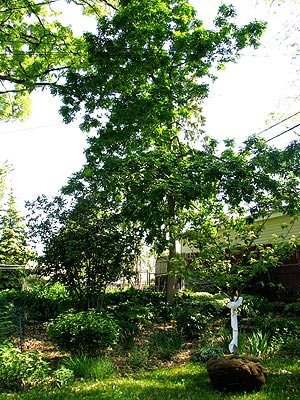 |
| The ash in question, with the ball-and-burlap Pagoda dogwood in foreground. |
The next-door neighbor had more than a little something to say about this, however. I sensed he was a bit put off by my very first act upon entering the property, which was using my Bobcat to rip out an ancient, immense Bridal Wreath spirea that was in full bloom just off the property line. This was at my client’s request, for having lived with the thing for twelve years she had reached the inevitable conclusion that a shrub that blooms for two weeks and then looks like hell for the next 50 is an overall landscape liability, even one that maintains a loud, wall-banging, two-week orgasm of bloom, as does dear old Bridal Wreath.
He asked if I had any other removal plans. The little ash in the corner, I replied.
What followed was a 72-hour debate on who owned the ash. After examining plat drawings and running a line between the two houses, it was determined that the ash was a few inches off the property line toward my client’s side.
Not good enough. Does it really need to come down?, he asked. Euphorians are so funny about trees. This was a sad little ash, a seed ash, perhaps twenty-five years old, that neither he nor my client nor any previous property owner had planted. It was growing straight up into the canopy of a large red oak not twenty feet away, and had a curving trunk and shrubby form as a result of lack of sufficient sunlight. That it had been hacked away on one side due to an overhead power line didn’t add anything to its charm.
I showed him the $200 Pagoda dogwood that his friendly neighbor had purchased and that I would plant just inside her property line, beautifying that corner of both properties for decades to come. I noted that the new tree would grow well with just the allotted morning sun, and that it would be decades before the top branches came under the scrutiny of the utility company, if ever. Then I mentioned the 21 other shrubs that she was spending several thousand additional dollars on, five of which would border his property, providing his side of the landscape with summer bloom and winter interest.
It all fell on deaf ears – especially the part about the shrubs. Though the roar of the Bobcat had no doubt piqued his interest, I had forgotten that Euphorians don’t really count shrubs for anything, even though they purify the air and provide healthy habitat for wildlife, and all those other precious things. The only plant type that registers with Euphorians are trees, and trees cannot be cut down, even if the plan is to replace the tree with a better tree.
My gracious client gave in, and we planted the Pagoda in a different spot, not as nice as the corner, but well within her jurisdiction. The ash remains, sad and sickly, no doubt among the first to go when the Emerald Ash Borer crosses the Mississippi and feasts in Minneapolis next year.
The Dire Economy
What recession? Some of the big boulder guys are noticing a shortage of jobs, but so far my landscaping season has been gangbusters. I should point out that I’ve bid on a lot of smaller jobs, and have been marketing more in that direction, but a day’s work is a day’s work. I like the smaller, two- to five-day jobs, tear out some ragged old shrubs, bump out the beds, bring in the cool stuff. I have openings in August (hint, hint) and September (the best time to plant trees and shrubs, hint, hint) but so far my crew and I have finished four jobs and have four more in the pipeline. I realize that last sentence is self-serving, but hell, it’s my site.
My theory is that with the crashing housing market, couples are looking at each other and saying hey, it looks like we’re not going to be moving up into a larger home, let’s plan on sticking around with this one. And if we’re going to do that, let’s spend a bit of money and finally do something about the landscaping, add a patio, plant some trees, add more shrubs. All fine by me.
Hand Injury
Not for the squeamish, but the irony is hysterical.
In late April I was tearing out landscape timbers with my crew, and I took my gloves off to answer my damn cell phone, which I should never have on and in my pocket when I’m trying to get some work done. I didn’t put my gloves back on as I lifted the next timber to throw it on the trailer, it slipped, and a jagged portion of the timber tore into my left palm.
Now, I’ve had slivers before, and they give a slight sting of wimpy pain, but this felt like I’d been stabbed. I could see the end of the sliver – the entrance was in that little fleshy mound about a half-inch below the base of the pinkie – so I put my gloves back on and finished the job.
When I took my gloves off to drive home, my hand was bloody, also a bit rare for a simple sliver wound. At home I washed it, got out the needle and tweezers, dug a bit, and pulled out a piece of wood. A piece of wood about a sixteenth of an inch long, and wider than that. The sliver had broken off, no doubt, because the short chit of wood I pulled from my hand would never have caused that much pain, or bleeding.
The next morning when I woke up for work, I could barely move my arm below my elbow, and couldn’t begin to move my pinkie and ring finger, swollen up twice their normal size as they were. I went to work – it takes only one hand to drive a stick-shift Ford F150 while sipping coffee, changing CDs, talking on a cell phone, jotting down a few notes, and taking a bite of donut – but while I was able to direct my crew and crack stupid jokes at the job site, from a labor standpoint I was pretty worthless. That night I attempted more explorative needle surgery, but the hand hurt so much it was impossible.
Two days later I’m in the emergency room, because this hand is on fire. Nice female doctor jabbed a needle into the swelling four times to introduce a pain killer (there’s a Catch-22 in there somewhere) then squeezed and pushed and finally said yeah, there’s a piece of wood in there. Then she got out the longest, biggest needle-nose tweezers you’ve ever seen, this thing belonged in a tackle box, rammed it down into the hole, and couldn’t quite reach it. Lord knows she tried.
I’m starting to pass out, she said that within two weeks the wood should float out by itself, and prescribed an antibiotic. I asked her if we couldn’t have handled this all by phone.
I’m basically useless for the next two weeks, driving a Bobcat with my right hand and left knee, soaking my hand in hot water and poking at the entrance hole each night so it doesn’t heal over. Finally the pain diminished, the swelling dropped by half, and fifteen days after the injury, while sitting in the tub, I saw a large brown spot in the center of the wound. I reached for the tweezers.
I have never, never experienced anything physical that felt so good as when I pulled that sliver out. Well, almost never. The thing was straight down into my hand, but came out like it was oiled. It also measured just over a half-inch long. I was so impressed, I took a picture.
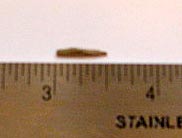 If you’re new to the site, the irony is, I hate the use of wood timbers in landscaping and bash them in about sixteen articles scattered throughout the site. This was no doubt their revenge, that lone timber rose up and caused the Renegade Gardener a fair bit of extended pain, both physical and financial, as payback.
If you’re new to the site, the irony is, I hate the use of wood timbers in landscaping and bash them in about sixteen articles scattered throughout the site. This was no doubt their revenge, that lone timber rose up and caused the Renegade Gardener a fair bit of extended pain, both physical and financial, as payback.
Then again, the only landscape material I bash more than wood timbers on this site is concrete retaining wall block, so I guess I should consider myself lucky.
Last Full Update
A reminder, this is the last full update until November 15. I’ll let this one run for a month, then on July 15 this dog-eared old site will revert to Archive mode, whereby I knock off a brief report each month that will appear on the Home Page, followed by a few suggested articles from the archives that you can access with a click. In November, when the landscaping season winds down and my sanity returns, I’ll come back on with new material.
In the meantime, new visitors, click around on the various buttons to the left, there’s plenty of helpful stuff scattered around, and often, more than you need to know.
Happy gardening – and keep your gloves on.
Don Engebretson
The Renegade Gardener